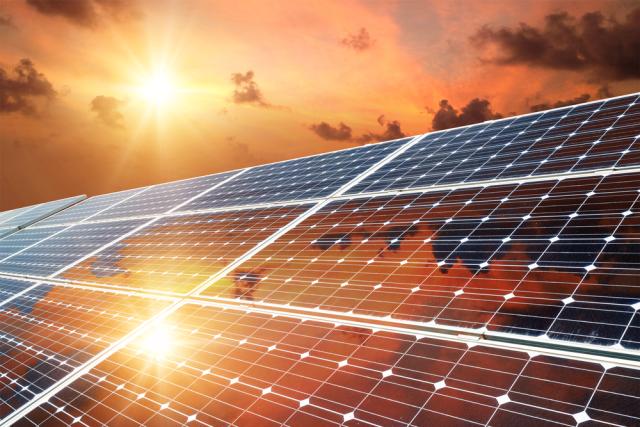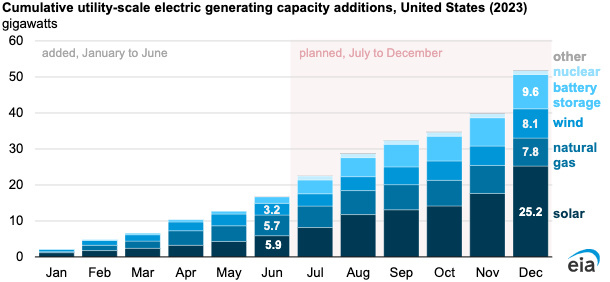
Solar developers are expected to lead the way toward another 35.2 gigawatts (GW) of total new utility-scale capacity additions in the U.S. for the second half of 2023, according to the U.S. Energy Information Administration (EIA). (Source: Shutterstock.com)
Solar developers are expected to lead the way toward another 35.2 gigawatts (GW) of total new utility-scale capacity additions in the U.S. for the second half of 2023, according to the U.S. Energy Information Administration (EIA).
Planned capacity for solar could reach 19.3 GW later this year, accounting for 55% of the total 2H23 capacity additions, the EIA said Aug. 8. About 7.8 GW of battery storage capacity additions are expected and 4.9 GW of wind.
The forecast, released this week as part of the EIA’s latest inventory of electric generators, was delivered as renewable energy companies pursue more new projects and start others that had been delayed, utilizing incentives made available in the Inflation Reduction Act.
The growth also comes as operators retire or prepare to retire some 15.3 GW of electric generating capacity from coal-fired and natural gas power plants amid the transition to lower carbon energy sources.
For the first half of 2023, the EIA reported developers added 16.8 GW of utility-scale generating capacity in the U.S. A power plant with a nameplate capacity of at least 1 megawatt is considered utility-scale.

At 5.9 GW, or 35%, solar power made up most of the growth during 1H23 though the EIA noted the new capacity was 4.6 GW less than expected due to supply chain constraints. Natural gas was a close second, accounting for 34%, or 5.7 GW, of new additions.
Florida led the nation with the most solar capacity additions during first-half 2023, with 25% of the U.S. total. Florida Power and Light (FPL), a subsidiary of NextEra Energy, dominated with new solar capacity additions.
NextEra CFO Kirk Crews highlighted FPL’s capital projects and pointed out how solar is the lowest cost alternative for its customers during a second-quarter earnings call in July. FPL has commissioned more than 1.6 GW of new solar generation in the last two years and anticipates adding about 3.1 GW of solar through 2025.
“FPL’s solar investments allow us to serve strong customer growth while providing clean, affordable generation and avoiding volatile fuel purchases,” Crews said. “Over the current four-year settlement agreement, we continue to expect FPL to make capital investments of between $32 to $34 billion. Of that total, we anticipate investing approximately $10 billion in new solar generation and approximately $14 to $16 billion in transmission and distribution infrastructure.”
Recommended Reading
CEO: Coterra ‘Deeply Curious’ on M&A Amid E&P Consolidation Wave
2024-02-26 - Coterra Energy has yet to get in on the large-scale M&A wave sweeping across the Lower 48—but CEO Tom Jorden said Coterra is keeping an eye on acquisition opportunities.
Buffett: ‘No Interest’ in Occidental Takeover, Praises 'Hallelujah!' Shale
2024-02-27 - Berkshire Hathaway’s Warren Buffett added that the U.S. electric power situation is “ominous.”
Why Endeavor Energy's Founder Sold His Company After Years of Rebuffing Offers
2024-02-13 - Autry Stephens', the 85-year-old wildcatter, decision to sell came after he was diagnosed with cancer, according to three people who discussed his health with him.
E&P Earnings Season Proves Up Stronger Efficiencies, Profits
2024-04-04 - The 2024 outlook for E&Ps largely surprises to the upside with conservative budgets and steady volumes.
Exxon Mobil, Chevron See Profits Fall in 1Q Earnings
2024-04-26 - Chevron and Exxon Mobil are feeling the pinch of weak energy prices, particularly natural gas, and fuels margins that have cooled in the last year.




